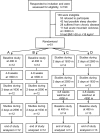Are nocturnal breathing, sleep, and cognitive performance impaired at moderate altitude (1,630-2,590 m)?
- PMID: 24293773
- PMCID: PMC3825448
- DOI: 10.5665/sleep.3242
Are nocturnal breathing, sleep, and cognitive performance impaired at moderate altitude (1,630-2,590 m)?
Abstract
Study objectives: Newcomers at high altitude (> 3,000 m) experience periodic breathing, sleep disturbances, and impaired cognitive performance. Whether similar adverse effects occur at lower elevations is uncertain, although numerous lowlanders travel to moderate altitude for professional or recreational activities. We evaluated the hypothesis that nocturnal breathing, sleep, and cognitive performance of lowlanders are impaired at moderate altitude.
Design: Randomized crossover trial.
Setting: University hospital at 490 m, Swiss mountain villages at 1,630 m and 2,590 m.
Participants: Fifty-one healthy men, median (quartiles) age 24 y (20-28 y), living below 800 m.
Interventions: Studies at Zurich (490 m) and during 4 consecutive days at 1,630 m and 2,590 m, respectively, 2 days each. The order of altitude exposure was randomized. Polysomnography, psychomotor vigilance tests (PVT), the number back test, several other tests of cognitive performance, and questionnaires were evaluated.
Measurements and results: The median (quartiles) apnea-hypopnea index at 490 m was 4.6/h (2.3; 7.9), values at 1,630 and 2,590 m, day 1 and 2, respectively, were 7.0/h (4.1; 12.6), 5.4/h (3.5; 10.5), 13.1/h (6.7; 32.1), and 8.0/h (4.4; 23.1); corresponding values of mean nocturnal oxygen saturation were 96% (95; 96), 94% (93; 95), 94% (93; 95), 90% (89; 91), 91% (90; 92), P < 0.05 versus 490 m, all instances. Slow wave sleep on the first night at 2,590 m was 21% (18; 25) versus 24% (20; 27) at 490 m (P < 0.05). Psychomotor vigilance and various other measures of cognitive performance did not change significantly.
Conclusions: Healthy men acutely exposed during 4 days to hypoxemia at 1,630 m and 2,590 m reveal a considerable amount of periodic breathing and sleep disturbances. However, no significant effects on psychomotor reaction speed or cognitive performance were observed.
Clinical trials registration: Clinicaltrials.gov: NCT01130948.
Keywords: Altitude; healthy; hypoxia; sleep apnea; vigilance.
Figures


References
-
- Khoo MC, Kronauer RE, Strohl KP, Slutsky AS. Factors inducing periodic breathing in humans: a general model. J Appl Physiol. 1982;53:644–59. - PubMed
-
- Reite M, Jackson D, Cahoon RL, Weil JV. Sleep physiology at high altitude. Electroencephalogr Clin Neurophysiol. 1975;38:463–71. - PubMed
-
- Salvaggio A, Insalaco G, Marrone O, et al. Effects of high-altitude periodic breathing on sleep and arterial oxyhaemoglobin saturation. Eur Respir J. 1998;12:408–13. - PubMed
-
- Burgess KR, Johnson P, Edwards N, Cooper J. Acute mountain sickness is associated with sleep desaturation at high altitude. Respirology. 2004;9:485–92. - PubMed
SUPPLEMENTAL REFERENCES
-
- Thurnheer R, Xie X, Bloch KE. Accuracy of nasal cannula pressure recordings for assessment of ventilation during sleep. Am J Respir Crit Care Med. 2001;164:1914–9. - PubMed
-
- Bloch KE, Li Y, Sackner MA, Russi EW. Breathing pattern during sleep disruptive snoring. Eur Respir J. 1997;10:576–86. - PubMed
-
- Bloch KE, Latshang TD, Turk AJ, Hess T, Hefti U, Merz TM, et al. Nocturnal periodic breathing during acclimatization at very high altitude at Mount Muztagh Ata (7,546 m) Am J Respir Crit Care Med. 2010;182:562–8. - PubMed
-
- Sackner MA, Watson H, Belsito AS, Feinerman D, Suarez M, Gonzalez G, et al. Calibration of respiratory inductive plethysmograph during natural breathing. J Appl Physiol. 1989;66:410–20. - PubMed
-
- Maarsingh EJ, van Eykern LA, Sprikkelman AB, Hoekstra MO, van Aalderen WM. Respiratory muscle activity measured with a noninvasive EMG technique: technical aspects and reproducibility. J Appl Physiol. 2000;88:1955–61. - PubMed
Publication types
MeSH terms
Associated data
LinkOut - more resources
Full Text Sources
Other Literature Sources
Medical

